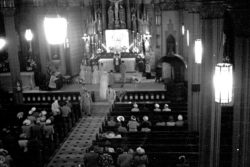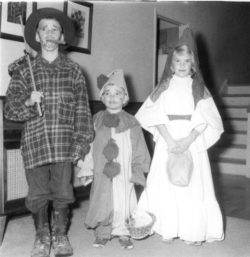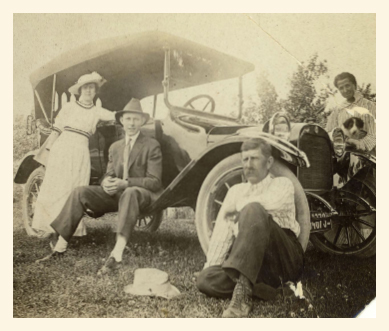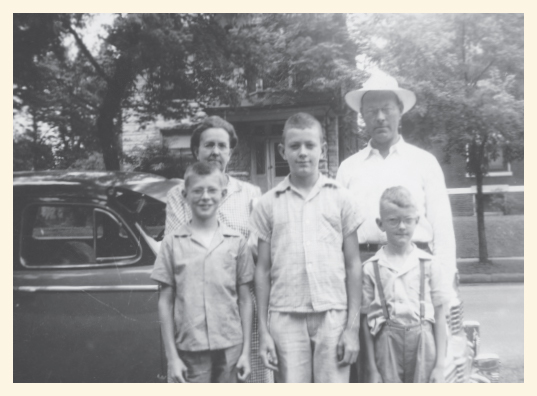By Eric Peterschmidt
Have we been “conditioned” to think of our family history like a family tree? Do we automatically think that a family history is mainly about the connections we have to our ancestors?
I think so. You?
And I think it’s why, for many, the notion of starting to pull together stories and photos to share with the rest of the family seems like it might be hard.
It doesn’t have to be that way.
We have learned that the very best way to capture family history is by taking an event-based approach.
Sure, it’s wonderful to know that you can trace your ancestors back to the 1600s. Your family tree could be very important to you. But don’t let it constrain how you look at establishing a family legacy for future generations to enjoy. The events of your past (and present) are every bit as important to remember as the people you’re connected to.
 Take a look at some of your own photos… just those you’ve accumulated over the past few years. Maybe you have them in albums on Facebook, or perhaps they’re still on your phone or the SD card from your camera. How many of those photos are all about events? A trip or vacation? A birthday party or family reunion? A beautiful family bike ride in the country? The road to recovery following surgery? A holiday gathering?
Take a look at some of your own photos… just those you’ve accumulated over the past few years. Maybe you have them in albums on Facebook, or perhaps they’re still on your phone or the SD card from your camera. How many of those photos are all about events? A trip or vacation? A birthday party or family reunion? A beautiful family bike ride in the country? The road to recovery following surgery? A holiday gathering?
Yes, family trees are important. However, they are only a small part of your family’s story… the part that shows how you are all related.
Where’s the narrative that can shed some light on all those relatives? What memories and stories accompany the events that are scattered throughout the branches sprouting from that tree?
When we think about our own lives and stories, we of course think about people. But we also naturally associate those people with events that occurred at certain times and places. Memories of those people, places, and events are often triggered by photos, videos, or other documents that were captured at the time.
But what happens to all those moments that were so conscientiously captured? They end up being scattered and hard to physically “get your arms around.” The event ends. Those in attendance all go their own way, taking their cameras – and all those captured moments – with them.
All the while, the family tree is the family tree. It shows how you’re all related. And outside of family connections, it’s generally independent of all those life-shaping events.
Why is that troubling? Let’s explore it further.
Genealogy is about tracing the lines of descent from an ancestor. Genealogists are researchers who look for and document the facts that prove or disprove various hypotheses about the lines of descent until there is no doubt about the lineage of a given person. They tend to take their work very seriously.
 Genealogists have access to amazing and expanding sources of information via the Internet, and there is an equally amazing set of research tools to help them find and capture facts and supporting information. Supporting information can include such things as ancestral photos, census information, official records, and newspaper clippings.
Genealogists have access to amazing and expanding sources of information via the Internet, and there is an equally amazing set of research tools to help them find and capture facts and supporting information. Supporting information can include such things as ancestral photos, census information, official records, and newspaper clippings.
Awesome.
But what about everything else? Where do grandpa’s WWII stories go? How about the stories about life on the farm during the depression, as told by all members of that family? Or the story of the ring that has been in your family for 150 years? What about the 1962 camping trip? Or last year’s “virtual” Thanksgiving? How about family recipes that have been handed down for generations? What about Duke, your family’s German Shepherd when you were a kid?
Granted, for some of our ancestors, especially those from more than 100 years ago, all we may really know are the facts discovered through research. So, the wonderful work that a family genealogist does could indeed account for everything that exists about their lives.
However, when family members are still alive, their own memories and the oral history that has been passed down to them from their ancestors still exist to be captured. That is the other part of the story – one that complements the genealogy ever so nicely.
But if no one makes the effort to harvest it – capture it for future generations – it will be lost forever.
That’s why we focus so much on the dash – that little line that separates birth and death dates on a tombstone. That is where the stories live, as we’ve discussed in prior posts (including this one - The Dash).
Genealogy is certainly more than birth and death dates, we know that. But the point here is that it is the soft stuff – the memories and stories that can so wonderfully bring that tree to life – that we learn the most from.
And there is clearly a sense of urgency here. Life is short… and unpredictable.
So, what to do?
First, acknowledge that “tree thinking” is mostly about genealogy… line of descent. Next, look beyond the tree and recognize that, along with the genealogy, family history needs to include the events of our lives as captured in photos, videos, clippings, and documents, and the memories and stories that accompany them – all wrapped up together.

Each of us has a dash that includes the events that make up our lives – the gatherings, the trips, the parties, the visits to the zoo, the weddings. What we do and who we do it with are what make us the people we are – and build the legacy we want to leave behind.
However, because “tree thinking” is so pervasive, we have not had a good place to capture the other pieces and share them in any sustainable way. We post our photos to Facebook, Instagram, or elsewhere… and, over time, we lose track of them. I’m imagining a time, years from now, when a grown kid wants to find the pictures of that Halloween, many years ago, when they dressed like the tooth fairy. Where are those pictures? How will you find them?
That’s why we advocate an event-based approach to creating a family legacy – whether you also have a family tree or not. It’s also why we created TightKnit the way we did. Events are kept in a private library, shared with designated family members, and always available for those family members to contribute to – making it all about “we,” not all about “me.”
In another post, I’m sharing some thoughts about how to organize and share an event-based approach to family history.
Go check it out here: The Trouble with Tree Thinking, Part II.




